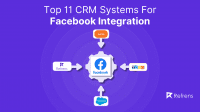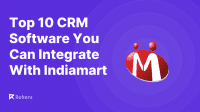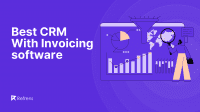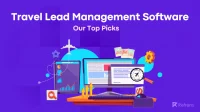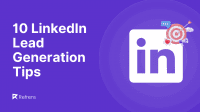Prospecting for sales by hand takes a lot of time and takes hours away from other sales activities that could increase revenue. The prospecting process can be automated and improved with the use of lead generation tools. By automating both incoming and outbound lead creation, it enables marketing teams to attract prospects with a higher buying potential.
The primary motivation for most marketers to purchase lead generating software is their inability to produce enough high-quality leads to meet pipeline goals.
Let’s go straight to the point: B2B lead generation tools can assist you in meeting your constantly expanding lead targets. However, and here is where the fun part comes in, the top lead generation tools may assist you in a lot more ways.
Lead generation
The process of drawing in and involving your target audience to the point that they feel compelled to provide you with their information is known as lead generation.
Sorting leads based on how you qualified them or on their current lifecycle stage helps you to convert leads into paying clients. Marketers use a variety of online tools to generate leads and convert them into customers.
Marketers have been cutting the cord from traditional lead generation and advertising to modern and more sophisticated techniques. Earlier, marketers used to advertise on traditional methods like billboards and TV. But now advertisers have shifted to more effective methods like advertising on mobile apps and websites as more and more customers are available on these platforms.
They can find good leads and potential customers on platforms like OTT apps, mobile apps, and websites. Also, they are using sophisticated lead generation tools to capture information about potential customers for their business. For example, websites like Firesticktricks provide valuable guidance on optimising streaming experiences on these OTT apps and platforms. Similarly, marketers utilise programmatic advertising, sponsored content, and targeted ads on OTT platforms to generate leads.
As more and more customers are available on new platforms, marketers are using those platforms for advertising and lead generation.
Lead generation tools
Let’s go back to the tools, often known as lead generators. To generate quality leads at scale, lead creation tools are helpful, but you’ll need to invest in automated lead generation software. This will help you cut down on manual labour.
Most of these software are available in the form of iOS and android apps, which makes it possible to install them on mobile devices. Let us explore the 15 best lead generation softwares available for small businesses.
1. Sales Handy
Sales Handy is a premier lead generation tool used by B2B SaaS, IT, and digital marketing agencies. It helps you set up automated email sequences to convert prospects into qualified leads at scale .
Using Saleshandy’s Connect Chrome plugin, which is a LinkedIn email finder, you may quickly obtain fresh leads. You may instantly add your prospects’ email addresses to your prospect lists and email sequences by using the addon. In this manner, you can start lead nurturing right away.
2. Leadfeeder
Leadfeeder is an effective solution that enables businesses to interact with firms that visit their website in real time and learn more about them. You can monitor their activities, learn about their interests, and utilise this information to optimise your website for increased engagement and conversions with Leadfeeder.
With multiple features, like automated lead scoring, flexible filtering, live visitor tracking, website forms tracking, email marketing integrations, strong contacts insight, and real-time notifications, Leadfeeder is the ideal choice for businesses trying to make their websites more effective.
3. HotJar
HotJar is a powerful tool for gathering input and examining user behaviour to enhance the customer journey and boost conversions. The business offers surveys, feedback widgets, heatmaps, and session recording. Together, they demonstrate what occurs on the website and the reasoning behind it.
A heatmap is one example. Insights such as the most clicked buttons, the depth of a page’s scroll, and the most engaging components are all visible. They may assist you in improving other metrics and reducing bounce rates in addition to lead generation on the website.
There are 900,000 users on HotJar from more than 180 nations. If money is tight and you don’t want specific integrations, it offers a free edition.
4. Picreel
Picreel is another great lead generating company that specialises in exit-intent technology. Users will see overlays and popups with an exit intent when they are about to leave.
The process involves locating the pointer movement to the top portion of the screen, which houses the “Back” and “Close” buttons. On smartphones, quickly scrolling upward can cause an exit-intent popup to appear.
Picreel promises to increase sales and create leads by streamlining the generation of these pop ups. How? It enables companies to create and display eye-catching pop ups to website users on a periodic basis.
With the software, you may alter text, colours, fonts, and even HTML and CSS with more than 100 popup layouts. You can solicit email addresses, advertise sales and merchandise, encourage viewers to submit reviews, and more.
The tool uses AI to improve A/B testing, analytics, and reporting. More than 700 apps are integrated with it. Additionally, Picreel lets you import leads into marketing software, CRMs, and content management systems for usage across departments.
5. Overloop
Overloop offers you all the elements required to manage an outbound multi-channel campaign. A chrome extension, CSV import, email finder, custom fields, LinkedIn contact import, and contact management are few of their contact management features.
Among its core competencies are features like cold emailing, large-scale LinkedIn automation, multi-channel campaigns, email threading, email tracking, and personalised message templates.
You’ll have to visit Overloop’s website to learn more about their features, which include robust reporting and increased sales efficiency.
6. OptinMonster
If you are looking for one of the greatest tools for creating leads, keeping sales from going away, and raising conversions, is OptinMonster. You may construct gamified wheels, scroll boxes, floating bars, pop ups, and other features using the toolkit. These solutions are necessary for engaging with visitors or gathering email addresses.
The best features are the drag-and-drop campaign builder and intuitiveness. Popups and welcome mats can be altered to suit your requirements. As an example, you can include buttons, countdown timers, animation, sound effects, and more.
With over 100 themes, OptinMonster makes sure you spend more time converting leads and less time creating popups. But if you don’t know how to code, you can still create overlays from scratch.
For mobile users, the tool now offers pop ups that are optimised for mobile devices. When you choose when the overlay appears, you have the following options:
When the tool detects exit intent, after a predetermined percentage of the page has been scrolled, or in accordance with other criteria.
Geo-location targeting with OptinMonster is another effective way to reach groups based on their whereabouts. Additionally, it provides campaigns with actionable insights. Conversion statistics, A/B testing techniques, and content targeting and personalization automation are all available.
7. Qualaroo
Qualaroo is a tool for gathering comments and building pools. You may utilise it to find out what visitors enjoy, get user feedback, and enhance your goods and services. They leave you contact details so you may get in touch with them later.
With the company’s pre-made templates, you may launch campaigns right away. After everything is operational, data analysis begins.
In order to identify sentiments, automate feedback mining, and initiate the necessary response, the tool gathers data and applies AI. For example, it can forward unfavourable responses to customer service representatives so they can address the concerns.
How does it operate? Qualaroo finds keywords and rates them, including “Joy,” “Anger,” “Disgust,” “Sadness,” and “Fear.”
The guidelines for displaying polls are as follows:
Surveys that appear on confirmation pages following purchases, and when a user is about to leave a website, to mention a few.
The Net Promoter Score is a tool that Qualaroo offers to gauge the likelihood that your customers would tell others about your company. For effective data management, it interfaces with Slack, Zapier, Salesforce, and other platforms.
8. HubSpot Marketing Hub
Hubspot Marketing Hub is a well known marketing tool for expanding any team. A lead management system with contact and campaign management features is included in the platform.
With its lead capture solution, The Marketing Hub assists companies in obtaining incoming leads through pop-ups, live chat, online forms, and chatbots. A free plan with certain restricted lead generation features is also available.
As per HubSpot, the application can also be integrated with your favoured email system, customer data platform (CDP), and customer relationship management (CRM) software.
9. LeadFuze
LeadFuze is a marketing, recruiting, and sales professional’s contact finder. Features like lead segmentation and verification are part of the software’s automated lead creation mechanism.
Users of LeadFuze can modify filters to conduct a market-based search and locate leads that are extremely specialised based on parameters like industry or workforce size. Alternatively, they can look up contact information for particular consumer segments by running an account-based search. Salespeople can, for instance, use a bulk query to obtain the email addresses of every C-level executive in a particular list of businesses. Your agents will have more time to work on their pitch rather than growing their list as a result.
10. Dealerfront
Dealerfront, formerly known as Leadfeeder, is a B2B sales prospecting and lead creation platform that complies with the General Data Protection Regulation (GDPR). Its features assist teams in charge of sales and support in generating leads and maintaining a pipeline of potential customers.
Salespeople can find prospects that easily fit into their target client profile with the aid of the tool’s more than 100 distinct filters. The user is then directed by this feature to comprehensive customer profiles that provide comprehensive, contextual information that aids in sales attempts without violating a person’s privacy rights.
Dealerfront is unique among many other solutions in that it facilitates both inbound and outbound lead creation. When a potential customer visits their website or makes an appearance in the media, the lead generating system notifies users through sales triggers.
11. Sumo
Sumo is one of the leading companies in the industry for email marketing. You may increase the size of your subscriber list and gather lead data with Sumo’s products. You can take advantage of features like welcome mats, drag-and-drop builders, and slide-in popups. For the convenience of checking your marketing pop ups, Sumo also offers a Chrome extension.
Sumo features a heatmap option that may help you figure out exactly where visitors are spending the most time on your site. Additionally, your website has a floating social share bar. The platform’s free edition and other affordably priced choices make it an excellent choice for small enterprises.
For listing, creating, and collecting emails on your website, Sumo is among the most widely used tools. Pop Ups, slide-in popups, and welcome mats—a popup email opt-in that takes over a complete page—are all available with this tool.
12. Sales Force
Salesforce helps companies handle leads and streamlines a number of easy chores. Together, the company’s marketing and sales clouds streamline both inbound and outbound lead generation
Sales teams can gather client information via web forms, social media, email, or any other inbound channel with the help of the Marketing Cloud Account Engagement capabilities.
Sales teams may generate prospect lists, automate outreach and lead scoring, and assign the best prospects to salespeople using the Salesforce CRM for outbound lead generation.
13. Zoho CRM
The platform offered by Zoho CRM assists companies in obtaining vital information from email marketing campaigns and capturing leads in order to spot new business prospects.
Sales teams can use Zoho to gather leads from social media listening and other inbound marketing initiatives like web forms. Users can hold virtual events with Zoho to further boost their prospecting efforts.
Zoho offers extensive analytics and more than 800 integrations to help business people monitor prospects and negotiate more profitable agreements.
14. Zuko
Businesses should choose Zuko if they don’t want to worry about different plugin alternatives or software. Its lead-generating materials are all accessible online. Thanks to the free trial, you may try the product out without having to pay any money. This platform’s capabilities include excellent analytics, campaign administration, keyword tracking, conversion tracking, multiple site management, and much more. Convert, Optimise, and JotForm are also connected.
Users of Zuko find that it increases conversion rates and provides them with insights. Conversely, other users say that it’s challenging to use the tools. It also comes at a very hefty cost.
15. Clearbit
Clearbit describes itself as the first AI Native Data Provider, more than just an email finder. The platform creates accurate data sets that can be utilised for B2B lead generation and B2B sales campaigns by combining its proprietary data with publicly available online data.
Because Clearbit automatically updates sales records with contact information, such as phone numbers, sales representatives love using it. With so many native connectors, such as those with Salesforce, Hubspot, and Zapier, it ought to blend well in with your IT stack. The drawback is that SMBs may find it costly.
Summing Up
By now, you know about the best lead generation apps for small businesses. However, these apps are not limited to be used by small businesses, but medium and large companies also use them to generate leads and convert them into buying customers. It’s important to spend some time on researching a variety of lead generation tools, know their features, compare them and finally choose the one that suits your business requirements.





